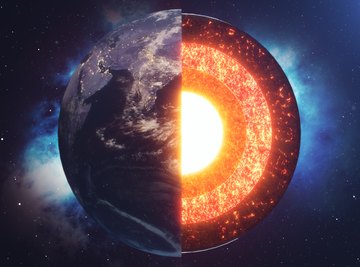
The Earth is a dynamic planet. It is made of layers: the crust, the mantle and the core. The mantle itself is an interesting zone, with differences between the upper and lower mantle. It helps to learn the upper mantle and lower mantle definition, along with their differencing characteristics, to greater understand the Earth’s geological behavior.
TL;DR (Too Long; Didn't Read)
The mantle is the layer of the Earth's interior between the crust or surface and the innermost core. The upper and lower mantle differ from each other in location, temperature and pressure.
The Earth’s Layers
You may remember making a model of the Earth in grade school out of clay. That model would have a cutaway, probably showing three distinct layers: the crust, mantle and core. However, the true nature of the Earth’s inner composition is more complex.
The outermost, thin layer called the crust is home to life on Earth. It is the surface you walk on, and the mountains and other landscapes you see. As vast as this layer may seem, the crust only makes up about 1 percent of the planet.
The mantle resides beneath the crust. This region makes up roughly 84 percent of the Earth. The crust and part of the upper mantle move around due to convection from heat in the Earth’s interior. This is called plate tectonics. This movement of tectonic plates causes earthquakes and forms mountains. Heat is generated from the radioactive decay of elements deep inside the Earth. Over time, this convective action changed the arrangement of continents. The gradual rising and falling of material in the mantle can bring forth magma through erupting volcanoes. Between the upper mantle and the core lies the lower mantle.
Beneath the lower mantle, the core makes up the Earth’s center and contains mostly iron and nickel. Its outermost layer is liquid, but its innermost layer is solid due to incredible pressure. This core is thought to rotate more quickly than other layers of the planet. It is also presumed to consist mainly of iron, but new discoveries reveal strange behavior of minerals. Scientists think the source of the Earth’s magnetic fields arises from the convective action of the molten outer core, which could displace flowing electric currents.
Upper Mantle Definition
The upper mantle definition is quite simply the layer just beneath the Earth’s crust. The mantle composition consists of mostly solid silicates. There are, however, areas that are molten. The upper mantle is therefore said to be viscous, with both solid and plastic characteristics. The upper mantle, along with the crust, comprises what is called the lithosphere. The lithosphere is approximately 120 miles or 200 kilometers thick. This is where the tectonic plates exist. Below the lithosphere, you'll find the asthenosphere. The lithosphere essentially glides over the asthenosphere as a series of tectonic plates. The depth of the upper mantle ranges between 250 to 410 miles (403 to 660 km). At this depth, rock can liquefy into magma. Magma then rises due to convection, and as it spreads it forms the ocean floor’s crust. This mostly silicate magma also contains dissolved carbon dioxide. This combination results in rocks melting at lower temperatures than they would without the carbon dioxide.
Lower Mantle Definition
The lower mantle definition is the region inside the Earth that resides beneath the upper mantle. At this level, there is much greater pressure than in the upper mantle, so the lower mantle is less viscous. The lower mantle alone comprises roughly 55 percent of the volume of the Earth. The lower mantle is approximately 410 to 1,796 miles (or 660 to 2,891 km) deep. Its upper reaches, just under the upper mantle, make up the transition zone. The core-mantle boundary is defined at the lower mantle's deepest point. The lower mantle composition consists of iron-rich perovskite, a ferromagnesian silicate mineral that is the most abundant silicate mineral on Earth. But scientists now think that perovskite exists in different states depending on the temperatures and pressures in the lower mantle. The lower mantle experiences extraordinary pressures that affect the behavior of minerals. One phase of perovskite would not have iron, for example, yet another possible phase would be rich in iron and have a hexagonal structure. This is called H-phase perovskite. Scientists continue to research possibly exotic, new minerals deep inside the lower mantle. Clearly this region promises intriguing new discoveries for years to come.
Compare and Contrast the Two Upper Layers of the Mantle
The science of seismology aids the understanding of the inner structure of the Earth. The data from seismology can provide data about the depth, pressure and temperature of the mantle, and the changes in minerals that result from these. Scientists can study characteristics of the mantle via the seismic wave speed after earthquakes. These waves move faster in denser material, where there is greater depth and pressure. They can study the changes in the mantle’s elastic qualities at boundaries called seismic discontinuities. Seismic discontinuities represent sudden jumps in seismic wave speeds across a boundary. Where perovskite can be found in the mantle, there is a seismic discontinuity separating the lower mantle from the upper mantle. With these various methods, as well as laboratory experiments and simulations, it is possible to compare and contrast the two upper layers of the mantle. There are three distinct differences between the upper and lower mantle.
The first difference between the upper mantle and lower mantle is their location. The upper mantle adjoins the crust to form the lithosphere, whereas the lower mantle never comes in contact with the crust. In fact, the upper mantle has been found to contain tears in certain areas, such as the Indian tectonic plate, whose collision with the Asian tectonic plate has caused many devastating earthquakes. These rips occur in multiple places in the upper mantle. The areas of crust above these tears are exposed to more of the mantle’s heat than other areas, and in those areas of warmer crust, the earthquakes are not as prevalent. The evidence from the research suggests that the crust and upper mantle in southern Tibet are strongly coupled. Information such as this can help with earthquake risk assessment.
Temperature is one of the differences between the two upper layers of the mantle. The upper mantle’s temperatures range from 932 to 1,652 degrees Fahrenheit (or 500 to 900 degrees Celsius). The lower mantle temperature, in contrast, reaches over 7,230 degrees Fahrenheit or 4,000 degrees Celsius.
Pressure is one great difference between the upper and lower mantle. The viscosity of the upper mantle is greater than the viscosity of the lower mantle. This is because there is less pressure at the upper mantle. The pressure of the lower mantle is far greater. In fact the pressure of the lower mantle ranges from 237,000 times atmospheric pressure to a high as 1.3 million times atmospheric pressure! While the temperature is vastly greater in the lower mantle and can melt rocks, the greater pressure prevents much melting.
It is important to study the characteristics of the Earth’s layers, to understand better how their interaction affects life on the surface. Better knowledge of the upper and lower mantle can aid in earthquake risk. Geologists can learn more about the viscosity of melting rocks and their characteristics under increasing pressure and depth. Understanding the layers of the Earth also aids in determining how the Earth was formed. While people cannot yet plumb the depths of the Earth the way they can the seas and space, scientists make it possible to predict the exotic qualities of the upper and lower mantle.
References
- University of Maryland Department of Geology: Upper Mantle Discontinuities
- Phys.org: New Model Reveals Rips in Earth's Mantle Layer Below Southern Tibet
- Phys.org: Earth's Lower Mantle Chemistry Breakthrough
- Universe Today: What Are the Earth’s Layers?
- National Science Foundation: Magma in Earth's Mantle Forms Deeper Than Once Thought
- Columbia University: Evidence for Internal Earth Structure and Composition
About the Author
J. Dianne Dotson is a science writer with a degree in zoology/ecology and evolutionary biology. She spent nine years working in laboratory and clinical research. A lifelong writer, Dianne is also a content manager and science fiction and fantasy novelist. Dianne features science as well as writing topics on her website, jdiannedotson.com.
